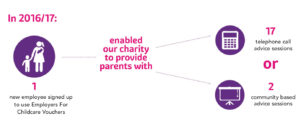Employers For Childcare: More than a Childcare Voucher company

To some, Employers For Childcare is simply a Childcare Voucher company.
To others — in fact, 10,406 working parents across the UK in the last year — Employers For Childcare is an invaluable source of guidance in the myriad of financial support available to parents. Working parents who contacted the organisation for a personal benefits check gained an average of £4,130 last year.
 Employers For Childcare is a charity that is active in its pursuit to make it easier for parents with dependent children to get into work and to stay in work. In order to fund its charitable services, Employers For Childcare operates the only Social Enterprise Childcare Voucher company in the UK, Employers For Childcare Vouchers, of which 100 per cent of the profit is donated to the charity.
Employers For Childcare is a charity that is active in its pursuit to make it easier for parents with dependent children to get into work and to stay in work. In order to fund its charitable services, Employers For Childcare operates the only Social Enterprise Childcare Voucher company in the UK, Employers For Childcare Vouchers, of which 100 per cent of the profit is donated to the charity.
Every parent and employer who uses Employers For Childcare Vouchers, as well as generating a saving themselves (a combined £15 million last year), also supports Employers For Childcare’s charity, which works directly with parents through the Family Benefits Advice Service and for parents through research, policy and lobbying work. The Family Benefits Advice Service helpline provides free, independent and confidential personalised benefits checks and better-off calculations to ensure families claim the best support available to them, particularly with childcare costs. The service is also available to employers, providing independent and confidential advice on a range of topics related to childcare support, flexible working, and workplace legislation such as maternity/paternity and shared parental leave.
 Part of Employers For Childcare’s most recent efforts is an extensive lobbying campaign to keep Childcare Vouchers open to new entrants beyond April 2018. The reason why? 66 per cent of parents who receive a personalised calculation from them are better off using Childcare Vouchers and/or Tax Credits rather than Tax-Free Childcare.
Part of Employers For Childcare’s most recent efforts is an extensive lobbying campaign to keep Childcare Vouchers open to new entrants beyond April 2018. The reason why? 66 per cent of parents who receive a personalised calculation from them are better off using Childcare Vouchers and/or Tax Credits rather than Tax-Free Childcare.
The Childcare Voucher scheme enables parents to salary sacrifice up to £243 of their salary per month which is exempt from tax and National Insurance contributions, saving each parent up to £933 per year (£1,866 if both parents use the scheme). Businesses also make a saving as the amount each parent swaps from their salary is exempt from National Insurance Contributions—employers in Northern Ireland saved £3.9 million last year through offering Employers For Childcare Vouchers.
While Employers For Childcare is lobbying Government to protect these savings for parents and the Northern Ireland economy by keeping Childcare Vouchers open to new entrants beyond April 2018, they are also educating employers on what they need to do now to make sure that neither they, nor their employees, miss out on this valuable benefit if it is to close.
Employers not already offering Childcare Vouchers should learn more about the scheme as soon as possible, once the scheme closes to new entrants, only employers who already offer the scheme can continue doing so. For employers already offering Childcare Vouchers, the more staff benefiting from Childcare Vouchers, the greater the savings through reduced Employer’s National Insurance Contributions. Once the Childcare Voucher scheme closes to new entrants however, employers will not be able to accept new entrants on to their scheme. Employers should inform staff of the changes now, so that there is time for those wishing to avail of Childcare Vouchers to join the scheme and make a salary sacrifice by the end of March 2018.
Further information about Employers For Childcare’s work as a Social Enterprise is available in their Social Impact Report 2016/17: www.employersforchildcare.org/socialimpact
Call Employers For Childcare for free, confidential and impartial advice on 0800 028 3008 whether as an employer, staff member working in a HR or payroll department, or as a working parent yourself: www.employersforchildcare.org






